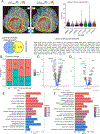Acute ocular hypertension in the living human eye: Model description and initial cellular responses to elevated intraocular pressure
- PMID: 39173459
- PMCID: PMC11444249
- DOI: 10.1016/j.visres.2024.108465
Acute ocular hypertension in the living human eye: Model description and initial cellular responses to elevated intraocular pressure
Abstract
This initial methods study presents the initial immunohistochemical and transcriptomic changes in the optic nerve head and retina from three research-consented brain-dead organ donors following prolonged and transient intraocular pressure (IOP) elevation. In this initial study, research-consented brain-dead organ donors were exposed to unilateral elevation of IOP for 7.5 h (Donor 1), 30 h (Donor 2), and 1 h (Donor 3) prior to organ procurement. Optic nerve tissue and retinal tissue was obtained following organ procurement for immunohistological and transcriptomic analysis. Optic nerve sections in Donor 1 exposed to 7.5-hours of unilateral sub-ischemic IOP elevation demonstrated higher levels of protein expression of the astrocytic marker, glial fibrillary acidic protein (GFAP), within the lamina cribrosa with greatest expression inferior temporally in the treated eye compared to control. Spatial transcriptomic analysis performed on optic nerve head tissues from Donor 2 exposed to 30 h of unilateral IOP elevation demonstrated differential transcription of mRNA across laminar and scleral regions. Immunohistochemistry of retinal sections from Donor 2 exhibited higher GFAP and IBA1 expression in the treated eye compared with control, but this was not observed in Donor 3, which was exposed to only 1-hour of IOP elevation. While there were no differences in GFAP protein expression in the retina following the 1-hour IOP elevation in Donor 3, there were higher levels of transcription of GFAP in the inner nuclear layer, and CD44 in the retinal ganglion cell layer, indicative of astrocytic and Müller glial reactivity as well as an early inflammatory response, respectively. We found that transcriptomic differences can be observed across treated and control eyes following unilateral elevation of IOP in brain dead organ donors. The continued development of this model affords the unique opportunity to define the acute mechanotranscriptomic response of the optic nerve head, evaluate the injury and repair mechanisms in the retina in response to IOP elevation, and enable correlation of in vivo imaging and functional testing with ex vivo cellular responses for the first time in the living human eye.
Keywords: Glaucoma; Inflammation; Intraocular pressure; Lamina cribrosa; Optic nerve; Retina macula; Spatial transcriptomics.
Copyright © 2024 The Author(s). Published by Elsevier Ltd.. All rights reserved.
Conflict of interest statement
Declaration of competing interest The authors declare that they have no known competing financial interests or personal relationships that could have appeared to influence the work reported in this paper.
Figures







References
-
- Anderson DR, and Hendrickson A (1974). Effect of intraocular pressure on rapid axoplasmic transport in monkey optic nerve. Int Ophthalmol, 13. - PubMed
-
- Bjornson-Hooper ZB, Fragiadakis GK, Spitzer MH, Chen H, Madhireddy D, Hu K, Lundsten K, McIlwain DR, & Nolan GP (2022). A Comprehensive Atlas of Immunological Differences Between Humans, Mice, and Non-Human Primates. Frontiers in Immunology, 13, 867015. 10.3389/fimmu.2022.867015 - DOI - PMC - PubMed
Publication types
MeSH terms
Substances
Grants and funding
LinkOut - more resources
Full Text Sources
Miscellaneous

